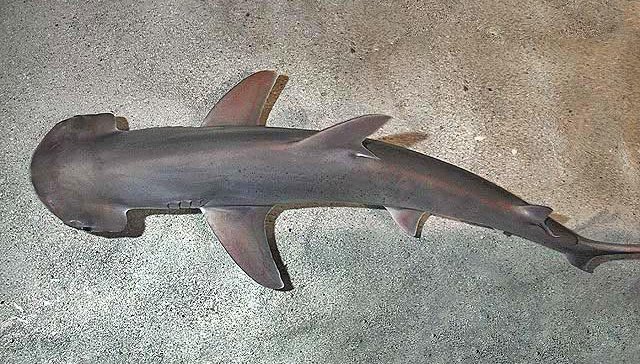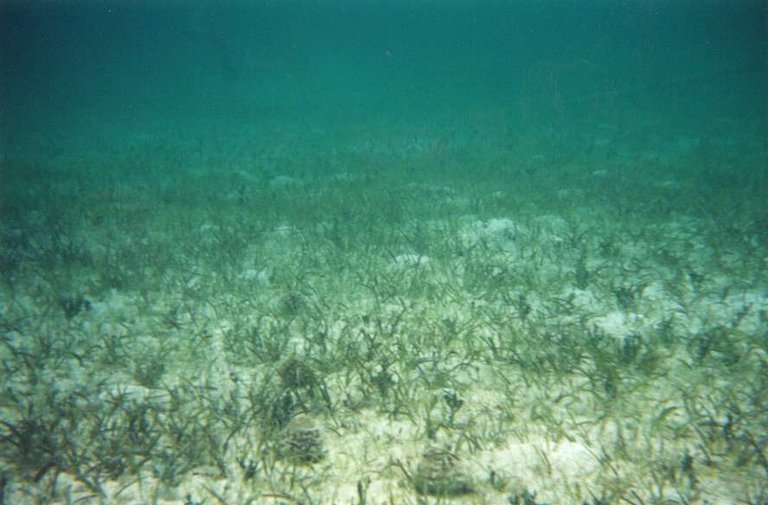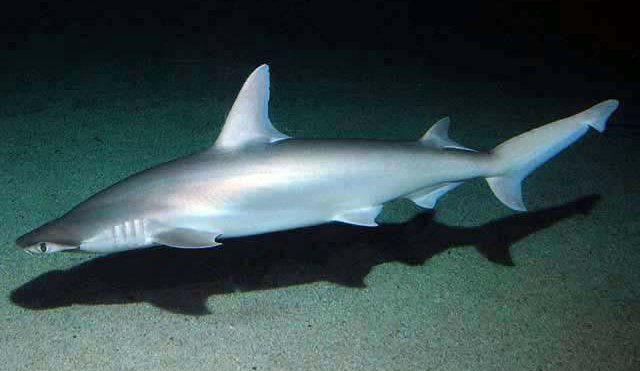We all have this presumption that sharks (Clade Selachimorpha) are supposed to be strictly carnivores, with many of the shark species being apex predator that throne at the very top of the food web in marine (and some freshwater) ecosystems.
Despite being over 500 different species worldwide, anyone had yet to see a herbivorous (plant-eating) or omnivorous (both plant and meat-eating) shark - until this year, when a group of researchers witnessed that a bonnethead shark (Sphyrna tiburo) was feeding on seagrass while searching on top of the sediments for small crabs, and decided to investigate this further.

A bonnethead shark. As you can see, it's a type of hammerhead shark. Image is Public Domain.
The bonnethead shark is actually a rather small shark, with full-grown individuals being just under a meter long. Another unique feature about them is that males and females have a different head morphology, which has not been seen in any other shark species. This allows people to identify the sex of the shark very easily, which is nice when you are studying them.
Finding out about the omnivorous nature of the bonnethead shark
People have long noticed that the gut content of bonnethead sharks was seemingly very high, with records of over 60 % of the gut content being made up of seagrasses. This did not really strike out as anything special at first, seeing as they mainly feed on crabs, shrimps, and mollusks who all live in the seagrass ecosystem, meaning it was natural to assume that all this seagrass in the gut was a side effect of feeding in this ecosystem. If it really was a side effect, then the seagrass would be of no nutritional value to the shark, as no one expected sharks to be able to digest plant matter.
A group of scientists from University of California in Irvine, and Florida International University in Miami decided to check if this really was the case, and began an experiment that would eventually lead to the discovery of the very first known omnivorous shark.
The experiment
Finding out if the shark was actually gaining nutrients from the seagrass might sound simple in theory, but actually doing a research experiment to finding this out is more complex than it might sound like at first.
To figure it out, they assembled huge aquariums where they planted lots of seagrass that was harvested in the Florida Bay. Once it took root in the aquarium they added radioactive isotopes of sodium bicarbonate to the water, which would then be used by the plants to build mass.

A typical seagrass meadow that would be planted in the lab. Photo is Public Domain.
This radioactive isotope gave a unique chemical signature to the plants, and if actually digested and used by the shark, would eventually be traceable in the cells of the sharks.
The next part was obviously to get sharks, and the research group put a total of five sharks in these aquariums with the isotope-marked plants. During the next three weeks the sharks were fed squid, and as expected they also ate a lot of the seagrass in the tank.
During these three weeks, all the sharks gained weight, so now the only thing left was to look for the radioactive isotopes in the sharks to determine if the seagrass had actually been digested and used for building cells.
The results
The researchers sampled the blood cells and liver tissues from the sharks, and found that roughly half of all the carbon from the seagrass had been digested by the shark. This is actually a pretty high amount, which matches the amount digested by herbivorous, marine non-fish such as sea turtles.
The shark lack the teeth needed to grind down the seaweed, so instead they must rely on another mechanism to break down the seaweed into a usable form. The same article claims that this is due to very strong stomach acids that allows the cells to be degraded enough for the enzymes to begin to break it down.

Photo is Public Domain.
They researchers also found specialized cellulose-component-degrading enzyme activity in the hindgut of the shark, giving them yet another indication that the shark actually utilizes the seagrass it eats.
Could there be other omnivorous sharks?
I love research like this, where the researchers actually find indications that what we have believed for a very long time, to be wrong or only partially true. After learning that this particular shark is actually omnivorous, the next step is to find out if there are more of them. And there very well could be, because no one has really looked at this before, so we certainly don't know.
I would actually be a bit surprised if we don't find more of these now, since we finally know that it's a thing we should be looking at. There are definitely many other shark species that feed in the seagrass meadow ecosystem, and it's entirely possible that many of these are also able to utilize the eaten seagrass to an extent.
Sources
Thanks for reading!
Please ask if anything was unclear with the post, or if there was something you wanted to be explained further. And thanks for stopping by!
Wao surprising...An omnivorous Shark Specie...How Cool!!!
And an ingenious idea of using radioactive tracer...I love stuff like this...
Thanks for yet another amazing article/discovery.
Yeah, it's a really cool discovery. I would probably not have thought about feeding them radioactive isotopes, even though it makes a lot of sense when you see their reasoning for it.
Wow, what a waste it would be, if 60% of the stomach content would just go to waste. I'm glad the shark has a chance to use all that orecious nutrition.
Do you know of other animal species where it is the case, that he majority if their stomach content is "accidental" and is not at all used uring the digestive process?
Hmm, that's a good question. But no, I can't name any at the top of my head.
It's interresting to hear about this bonnethead shark which eating plants, but to be serious the great sensation for me is the fact there exist 500 species of shark, that's unbelievable.
Hehe, yeah, it's pretty crazy that there are so many different shark species! I bet most people believe there are 10-20 of them.
Definetely, anyway that's what I thought.
Huh? A plant eating shark. Would have never guessed that. Guess you learn new things every day.
Yeah, it's pretty cool! But keep in mind that it eats meat as well - not only plants.
This is amazing! I love sharks, and this one is so cute!
/FF
Yeah, all hammerhead sharks are pretty cute (in my opinion). Thanks for stopping by my blog!
That one is the cutest!
/FF
wao this is soo beautiful and large shark. i love shark .this is one shark but sooo beautiful.fish human body give protine soo i love fish.
Yeah, it's a nice-looking shark for sure! :)
Wow!!!!
This is epic!
Thanks for sharing 😜
You're welcome :)
Very big and beautiful shark.Many benefis of shark in our body.Fish gives you proteins.I love to eat fish.fish is so tasty food.Thanks for sharing.
You probably shouldn't eat shark though; a lot of the shark species are already considered vulnerable or endangered when it comes to potential extinction, and the bioaccumulation of heavy metals might not be good for you. I would suggest sticking fish that are lower down on the trophic levels.
Lol dickhead shark
Posted using Partiko Android
Hi @valth!
Your post was upvoted by @steem-ua, new Steem dApp, using UserAuthority for algorithmic post curation!
Your UA account score is currently 5.157 which ranks you at #875 across all Steem accounts.
Your rank has improved 1 places in the last three days (old rank 876).
In our last Algorithmic Curation Round, consisting of 516 contributions, your post is ranked at #114.
Evaluation of your UA score:
Feel free to join our @steem-ua Discord server
This post has been voted on by the SteemSTEM curation team and voting trail in collaboration with @curie.
If you appreciate the work we are doing then consider voting both projects for witness by selecting stem.witness and curie!
For additional information please join us on the SteemSTEM discord and to get to know the rest of the community!
Awesome, thanks! I already have you voted as a witness :)